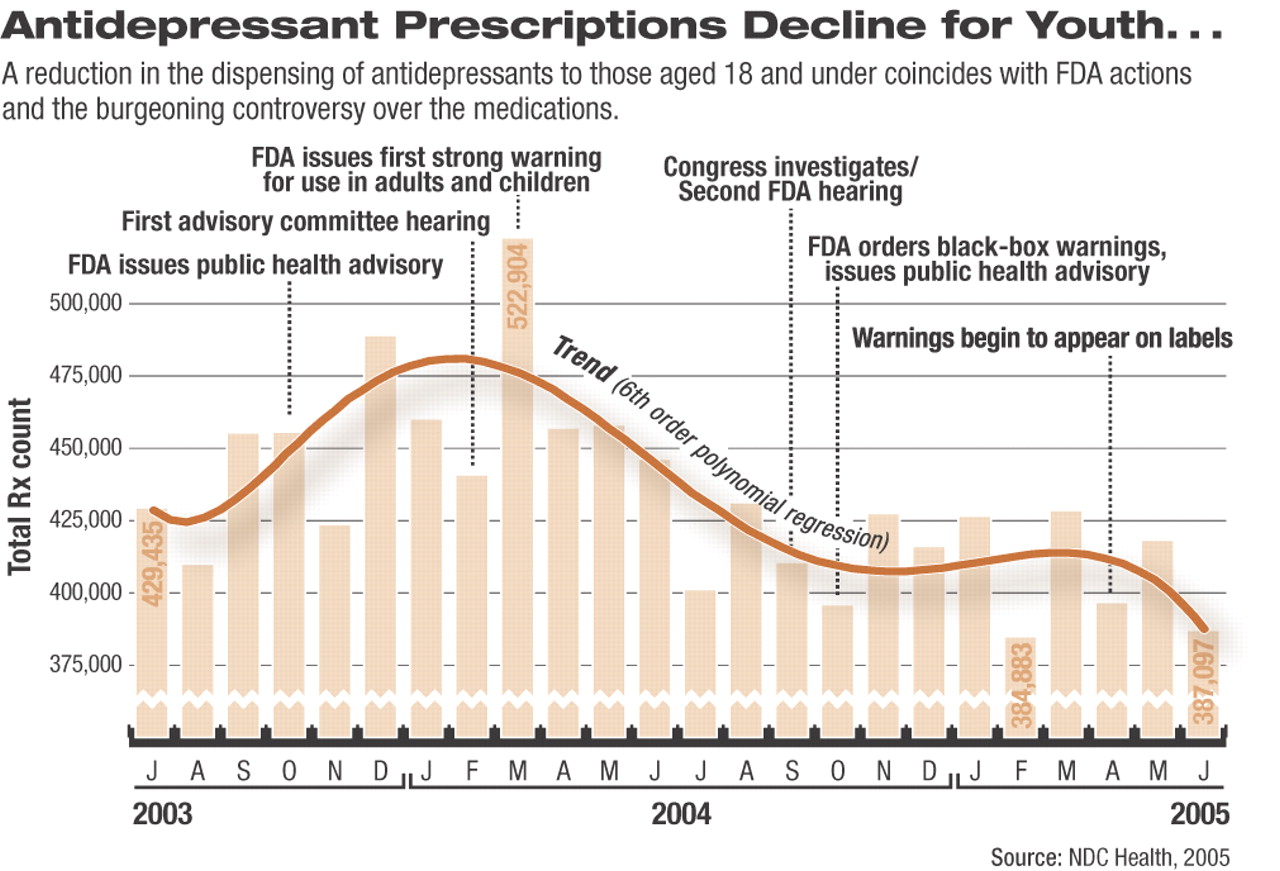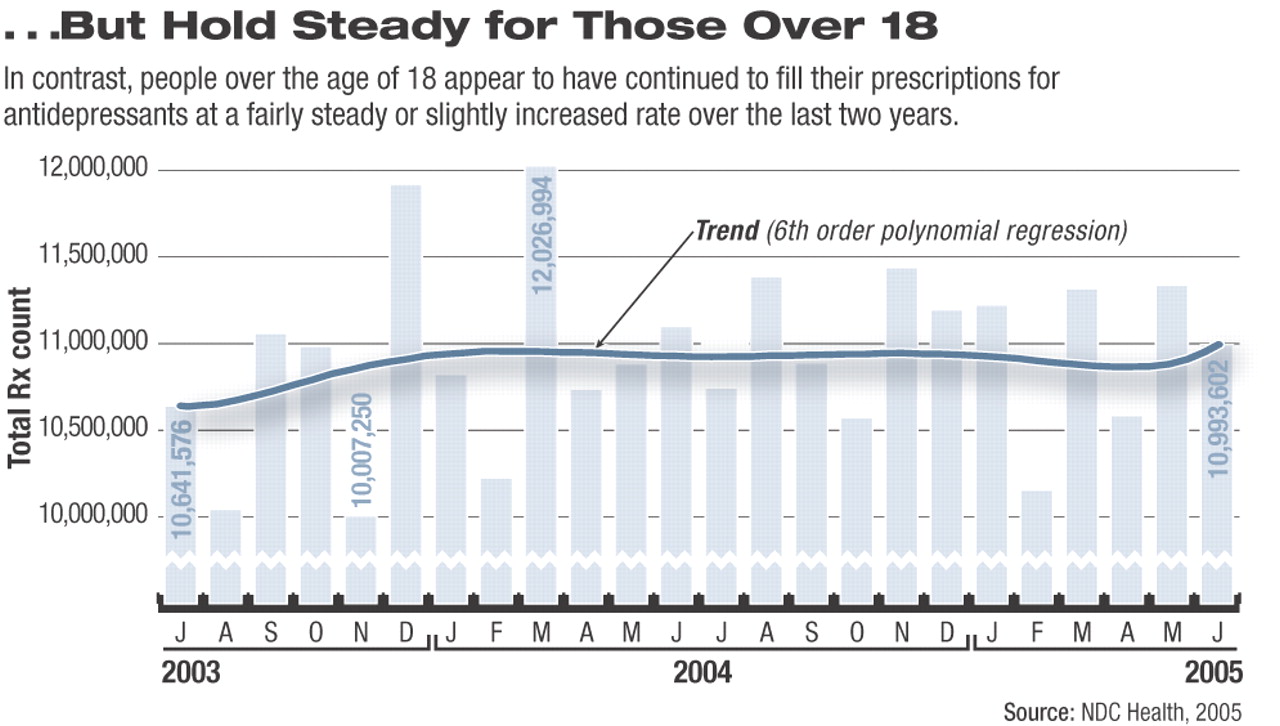Newly released data show that the number of antidepressant prescriptions dispensed to patients aged 18 and under has dropped nearly 20 percent since the Food and Drug Administration (FDA) issued its public health advisory on March 22, 2004, warning that the drugs might be associated with an increased risk of suicidality in both children and adults.
The number of antidepressant prescriptions dispensed to adults has held fairly steady over the last two years.
The changes in dispensing were calculated based on the number of prescriptions dispensed from March 31, 2004, to June 30, 2005, compared with the anticipated number of prescriptions that would have been dispensed over that same time had the number of prescriptions dispensed each month remained constant at the March 2004 level.
The trends were revealed in data requested by Psychiatric News from Atlanta-based NDC Health Inc. The company, which says it processes 5 billion health care transactions annually, tracks prescription-dispensing data nationally through electronic connections with “more than 90 percent of U.S. pharmacies.”
NDC Health provided Psychiatric News exclusively with two years' worth of monthly prescription data, showing the total number of prescriptions dispensed each month and the total cost of those prescriptions from July 2003 through June 2005. The data were reported as monthly total numbers and costs for patients aged 18 and under and for patients over age 18. The data cover all antidepressants, including SSRIs, SNRIs, atypical antidepressants, tricyclics, and MAOIs.
Psychiatric News analyzed the data to determine whether the rate of dispensing prescriptions for the two populations had changed in that time period.
The dataset begins seven months before the FDA's first public meeting on antidepressant use in children by the Psychopharmacologic Advisory Committee and Pediatric Subcommittee in February 2004 (Psychiatric News, March 5, 2004; March 19, 2004; April 16, 2004) and cover the ensuing 17 months of turmoil, which included Congressional hearings and additional advisory committee meetings. Those public meetings resulted in the FDA's announcement of, and eventual implementation of, black-box warnings on labels of all antidepressants marketed in the United States (Psychiatric News, October 15, 2004; November 5, 2004; March 5, 2005).
“These data demonstrate a dramatic shift in practice patterns over a very brief period of time,” David Fassler, M.D., told Psychiatric News.
Fassler is an APA trustee and a clinical professor of psychiatry at the University of Vermont. A child and adolescent psychiatrist, he has been at the forefront of APA's involvement with the regulatory process concerning antidepressant medication use in children and adolescents and testified on APA's and AACAP's behalf at the Congressional hearings and APA's behalf at FDA advisory committee meetings. (At the FDA hearings AACAP was represented by Laurence Greenhill, M.D.)
Darrel Regier, M.D., M.P.H., executive director of the American Psychiatric Institute for Research and Education and director of APA's Division of Research, commented, “It looks like the earlier warning in February 2004 clearly had an effect on prescribing, in contrast to the FDA's report at the September 2004 hearings,” after which a much smaller decline in prescribing occurred (see chart at right).”
John March, M.D., M.P.H., a professor of psychiatry at Duke University, told Psychiatric News, “These data confirm what others have seen—namely, that the FDA process has resulted in a decrease in the number of prescriptions for antidepressants written for children and adolescents.”
March was the principal investigator on the National Institute of Mental Health's Treatment of Adolescents With Depression Study (TADS) (Psychiatric News, September 3, 2004; July 1).
Prescriptions Decline Significantly
All of those contacted by Psychiatric News agreed with its analysis, whether the data are shown as total number of prescriptions dispensed each month over the two-year period beginning with July 2003 or as a percentage change in the number of prescriptions dispensed each month calculated from the base month of March 2004, when the number of prescriptions peaked (see chart at right).
A third analysis (not depicted here) showed similar trends. That analysis looked at the percentage of change in the number of prescriptions written by quarter, compared with the same quarter in the previous year.
The number of antidepressant prescriptions dispensed was increasing from the beginning of July 2003 through March 2004, in both pediatric and adult populations—an upward trend confirmed by previously published data showing steadily increasing annual sales figures for the antidepressant class over the last several years.
However, according to the NDC Health data, during April 2004—just after the FDA's March 22 Public Health Advisory that resulted from the February meeting of the advisory committees—the number of prescriptions dispensed to both adults and to children dropped precipitously. Indeed, in just one month, the number of antidepressant prescriptions for those over the age of 18 declined by 10.7 percent, while prescriptions for those aged 18 and under declined 12.6 percent.
The dataset that NDC Health gave to Psychiatric News for this article indicates that the decline in dispensing of antidepressant prescriptions that began in April 2004 has continued for those aged 18 and under. Depending on whether one looks at the trend over the entire two-year period, or the trend since the peak in March 2004, the rate of dispensing to adults has either leveled off or declined.

As a percentage of change in antidepressant prescribing relative to the dataset's July 31, 2003, baseline, the number of prescriptions for adults was on the upswing. Though there were wide monthly fluctuations in the number of prescriptions dispensed to adults between July 31, 2003, and March 31, 2004, the number of prescriptions rose an average of about 4 percent. During the same period, the number of prescriptions for those 18 and under rose an average of just over 10 percent. However, between March 31, 2004, and June 30, 2005, prescribing to adults (again as a percentage change relative to the same July 31, 2003, baseline) held fairly stable, ending the month of June 2005 at 5 percent above the end of July 2003. In contrast, prescribing to children ended 10 percent below where it stood at the end of July 2003.
Data Provoke Many Questions
Regardless of how the decline is measured, however, for those aged 18 and under the drop is statistically significant (p=0.01). For adults, the prescribing pattern over the two-year period does not change significantly. However, the clinical implications of these data, particularly of the decline in pediatric antidepressant prescriptions, appears to be in the eye of the beholder.
“These data clearly suggest that there are children and adolescents with depression who no longer have access to the full range of effective and appropriate treatment options,” Fassler told Psychiatric News.
“This picture is disastrous,” said Gail Griffith, who sat on the FDA's advisory panel as a patient representative (Psychiatric News, May 20). “The real question I want answered is, Why?”
If the decline is coming from “physician reluctance,” Griffith said, “it may be due to lack of education or fear of liability or malpractice [associated with prescribing the drugs].” However, she continued, “if the reluctance is coming from the public, then we have an opportunity here to provide evidence and educate.”
Thomas Laughren, M.D., acting director of the FDA's Division of Psychiatry Products, reiterated in an e-mail to
Psychiatric News that “the intent of the strong warning statements was not to discourage appropriate prescribing of these drugs to pediatric patients, but rather to alert prescribers, patients, and their families to the increased risk” (see
box).
“We do not know whether the impact is positive, neutral, or negative,” said Duke's March. “It will be important to evaluate the outcome of this natural experiment on suicide attempts and on completed suicide to know whether the appropriate caution in prescribing and call for increased monitoring is a net plus or not.”
If Not Drugs, Then What?
Nearly every one Psychiatric News interviewed agreed that the 20 percent drop in antidepressant prescriptions for children between April 2004 and June 2005 does not indicate any significant remission rate. Quite the opposite.
Adelaide Robb, M.D., who directs the adolescent inpatient unit at Children's National Medical Center in Washington, D.C., said the data are“ worrisome.” She told Psychiatric News, “You have to ask, Is there a corresponding increase in use of treatments like cognitive-behavioral therapy or interpersonal therapy, treatments that have proven effective with adults? Without medications, though, are these kids getting any treatment at all?”
“Our sense from this and similar data is that at the same time that there's been this drop in use of antidepressants, there has been a compensatory increase in the use of atypical antipsychotics in this population,” added Thomas Insel, M.D., director of the National Institute of Mental Health (NIMH). “And that is of great concern because we have very little safety data and very little evidence of efficacy, for that matter. These drugs simply haven't been studied much in children.”
Insel added that although he thought the data were “entirely predictable,” he is bothered by the fact that the the decline “is entirely driven by a focus on risk and a neglect of benefit.”
Insel noted that NIMH has large studies under way “looking at whether the decrease in SSRI utilization might be associated with an increase in suicidality rather than a drop in suicide, and my expectation is that we may see an increase.”
Insel said that he thinks psychiatrists will be concerned when they see the information presented in this article. “We must use this as a wake-up call,” he said. ▪



